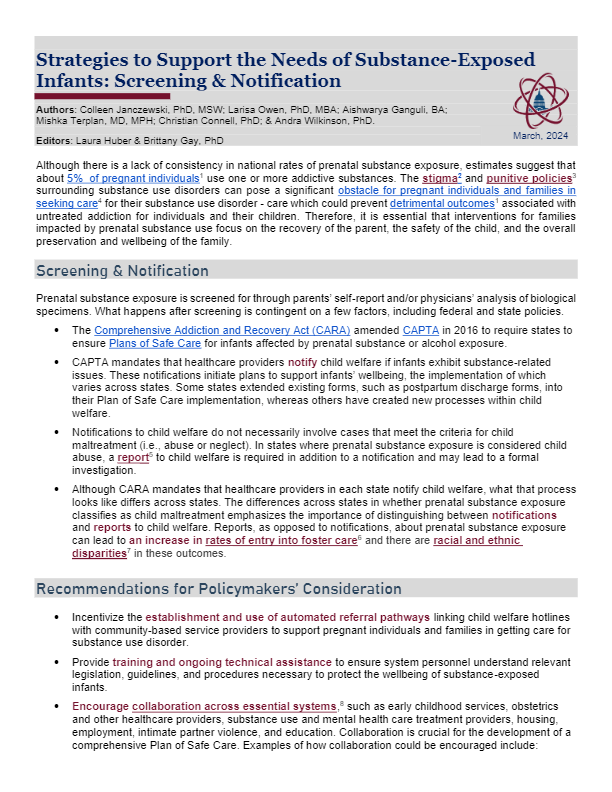
Although there is a lack of consistency in national rates of prenatal substance exposure, estimates suggest that about 5% of pregnant individuals (1) use one or more addictive substances. The stigma (2) and punitive policies (3) surrounding substance use disorders can pose a significant obstacle for pregnant individuals and families in seeking care (4) for their substance use disorder – care which could prevent detrimental outcomes (1) associated with untreated addiction for individuals and their children. Therefore, it is essential that interventions for families impacted by prenatal substance use focus on the recovery of the parent, the safety of the child, and the overall preservation and wellbeing of the family.
Screening & Notification
Prenatal substance exposure is screened for through parents’ self-report and/or physicians’ analysis of biological specimens. What happens after screening is contingent on a few factors, including federal and state policies.
- The Comprehensive Addiction and Recovery Act (CARA) amended CAPTA in 2016 to require states to ensure Plans of Safe Care for infants affected by prenatal substance or alcohol exposure.
- CAPTA mandates that healthcare providers notify child welfare if infants exhibit substance-related issues. These notifications initiate plans to support infants’ wellbeing, the implementation of which varies across states. Some states extended existing forms, such as postpartum discharge forms, into their Plan of Safe Care implementation, whereas others have created new processes within child welfare.
- Notifications to child welfare do not necessarily involve cases that meet the criteria for child maltreatment (i.e., abuse or neglect). In states where prenatal substance exposure is considered child abuse, a report (5) to child welfare is required in addition to a notification and may lead to a formal investigation.
- Although CARA mandates that healthcare providers in each state notify child welfare, what that process looks like differs across states. The differences across states in whether prenatal substance exposure classifies as child maltreatment emphasizes the importance of distinguishing between notifications and reports to child welfare. Reports, as opposed to notifications, about prenatal substance exposure can lead to an increase in rates of entry into foster care (6) and there are racial and ethnic disparities (7) in these outcomes.
Recommendations for Policymakers’ Consideration
- Incentivize the establishment and use of automated referral pathways linking child welfare hotlines with community-based service providers to support pregnant individuals and families in getting care for substance use disorder.
- Provide training and ongoing technical assistance to ensure system personnel understand relevant legislation, guidelines, and procedures necessary to protect the wellbeing of substance-exposed infants.
- Encourage collaboration across essential systems (8), such as early childhood services, obstetrics and other healthcare providers, substance use and mental health care treatment providers, housing, employment, intimate partner violence, and education. Collaboration is crucial for the development of a comprehensive Plan of Safe Care. Examples of how collaboration could be encouraged include:
- Sharing data and other relevant information across inter- and intra-state agencies;
- Convening state-led workgroups with representation across systems; and
- Highlighting how funds from various sources could be used to strengthen prevention efforts, build, and improve connections across systems, such as child welfare and addiction treatment providers. For example, the Family First Prevention Services Act (FFPSA) enables the use of funds for prevention services, including substance abuse prevention and treatment, to prevent unnecessary out-of-home placements.
- Implement strategies to reduce the stigma and discrimination associated with parental substance use disorders as a crucial step in effectively engaging families. One example is educating workforces who typically interact with families, such as those in healthcare, child welfare, and the justice system, as well as the general public about substance use disorder and family-centered approaches to care.
- Encourage routine analysis of available data by collaborative teams. This is necessary to adapt service approaches as needed, evaluate delivery of culturally responsive services, address any disparate outcomes, and ensure sustained funding support.
Select Resources
- Wendell, A. D. (2013). Overview and epidemiology of substance abuse in pregnancy.
- National Center on Substance Abuse and Child Welfare (2021). How states serve infants and their families affected by prenatal substance exposure series.
- Sieger et al. (2022). Novel implementation of state reporting policy for substance-exposed infants.
- Deutsch et al. (2022). Impact of Plans of Safe Care on prenatally substance exposed infants.
_____________
1 Wendell, A. D. (2013). Overview and epidemiology of substance abuse in pregnancy.
2 Weber et al. (2021). Substance use in pregnancy: Identifying stigma and improving care.
3 Faherty et al. (2019). Association of punitive and reporting state policies related to substance use in pregnancy with rates of neonatal abstinence syndrome.
4 Stone, R. (2015). Pregnant women and substance use: Fear, stigma, and barriers to care.
5 Austin et al. (2022). Association of state child abuse policies and mandated reporting policies with prenatal and postpartum care among women who engaged in substance use during pregnancy.
6 Atkins et al. (2021). The impact of state-level prenatal substance use policies on infant foster care entry in the United States.
7 Rebbe et al. (2019). Child protection reports and removals in infants diagnosed with prenatal substance exposure.
8 NCSACW (2021). How states serve infants and their families affected by prenatal substance exposure: Lessons from implementation of Plans of Safe Care.
Related Resources
The Research-to-Policy Collaboration (RPC) works to bring together research professionals and public officials to support evidence-based policy. Please visit their website to learn more.
Key Information
RPC Website
Research-to-Policy Collaboration
More RPC Resources
RPC Resources
Publication DateApril 2, 2024
Topic Area(s)Social Services, Education and Child Development, Health, Substance Use and Misuse
Resource TypeWritten Briefs
Share This Page
Although there is a lack of consistency in national rates of prenatal substance exposure, estimates suggest that about 5% of pregnant individuals (1) use one or more addictive substances. The stigma (2) and punitive policies (3) surrounding substance use disorders can pose a significant obstacle for pregnant individuals and families in seeking care (4) for their substance use disorder – care which could prevent detrimental outcomes (1) associated with untreated addiction for individuals and their children. Therefore, it is essential that interventions for families impacted by prenatal substance use focus on the recovery of the parent, the safety of the child, and the overall preservation and wellbeing of the family.
Screening & Notification
Prenatal substance exposure is screened for through parents’ self-report and/or physicians’ analysis of biological specimens. What happens after screening is contingent on a few factors, including federal and state policies.
- The Comprehensive Addiction and Recovery Act (CARA) amended CAPTA in 2016 to require states to ensure Plans of Safe Care for infants affected by prenatal substance or alcohol exposure.
- CAPTA mandates that healthcare providers notify child welfare if infants exhibit substance-related issues. These notifications initiate plans to support infants’ wellbeing, the implementation of which varies across states. Some states extended existing forms, such as postpartum discharge forms, into their Plan of Safe Care implementation, whereas others have created new processes within child welfare.
- Notifications to child welfare do not necessarily involve cases that meet the criteria for child maltreatment (i.e., abuse or neglect). In states where prenatal substance exposure is considered child abuse, a report (5) to child welfare is required in addition to a notification and may lead to a formal investigation.
- Although CARA mandates that healthcare providers in each state notify child welfare, what that process looks like differs across states. The differences across states in whether prenatal substance exposure classifies as child maltreatment emphasizes the importance of distinguishing between notifications and reports to child welfare. Reports, as opposed to notifications, about prenatal substance exposure can lead to an increase in rates of entry into foster care (6) and there are racial and ethnic disparities (7) in these outcomes.
Recommendations for Policymakers’ Consideration
- Incentivize the establishment and use of automated referral pathways linking child welfare hotlines with community-based service providers to support pregnant individuals and families in getting care for substance use disorder.
- Provide training and ongoing technical assistance to ensure system personnel understand relevant legislation, guidelines, and procedures necessary to protect the wellbeing of substance-exposed infants.
- Encourage collaboration across essential systems (8), such as early childhood services, obstetrics and other healthcare providers, substance use and mental health care treatment providers, housing, employment, intimate partner violence, and education. Collaboration is crucial for the development of a comprehensive Plan of Safe Care. Examples of how collaboration could be encouraged include:
- Sharing data and other relevant information across inter- and intra-state agencies;
- Convening state-led workgroups with representation across systems; and
- Highlighting how funds from various sources could be used to strengthen prevention efforts, build, and improve connections across systems, such as child welfare and addiction treatment providers. For example, the Family First Prevention Services Act (FFPSA) enables the use of funds for prevention services, including substance abuse prevention and treatment, to prevent unnecessary out-of-home placements.
- Implement strategies to reduce the stigma and discrimination associated with parental substance use disorders as a crucial step in effectively engaging families. One example is educating workforces who typically interact with families, such as those in healthcare, child welfare, and the justice system, as well as the general public about substance use disorder and family-centered approaches to care.
- Encourage routine analysis of available data by collaborative teams. This is necessary to adapt service approaches as needed, evaluate delivery of culturally responsive services, address any disparate outcomes, and ensure sustained funding support.
Select Resources
- Wendell, A. D. (2013). Overview and epidemiology of substance abuse in pregnancy.
- National Center on Substance Abuse and Child Welfare (2021). How states serve infants and their families affected by prenatal substance exposure series.
- Sieger et al. (2022). Novel implementation of state reporting policy for substance-exposed infants.
- Deutsch et al. (2022). Impact of Plans of Safe Care on prenatally substance exposed infants.
_____________
1 Wendell, A. D. (2013). Overview and epidemiology of substance abuse in pregnancy.
2 Weber et al. (2021). Substance use in pregnancy: Identifying stigma and improving care.
3 Faherty et al. (2019). Association of punitive and reporting state policies related to substance use in pregnancy with rates of neonatal abstinence syndrome.
4 Stone, R. (2015). Pregnant women and substance use: Fear, stigma, and barriers to care.
5 Austin et al. (2022). Association of state child abuse policies and mandated reporting policies with prenatal and postpartum care among women who engaged in substance use during pregnancy.
6 Atkins et al. (2021). The impact of state-level prenatal substance use policies on infant foster care entry in the United States.
7 Rebbe et al. (2019). Child protection reports and removals in infants diagnosed with prenatal substance exposure.
8 NCSACW (2021). How states serve infants and their families affected by prenatal substance exposure: Lessons from implementation of Plans of Safe Care.
Related Resources
The Research-to-Policy Collaboration (RPC) works to bring together research professionals and public officials to support evidence-based policy. Please visit their website to learn more.

Key Information
RPC Website
Research-to-Policy Collaboration
More RPC Resources
RPC Resources
Publication DateApril 2, 2024
Topic Area(s)Social Services, Education and Child Development, Health, Substance Use and Misuse
Resource TypeWritten Briefs
Share This Page
LET’S STAY IN TOUCH
Join the Evidence-to-Impact Mailing List
Keep up to date with the latest resources, events, and news from the EIC.




